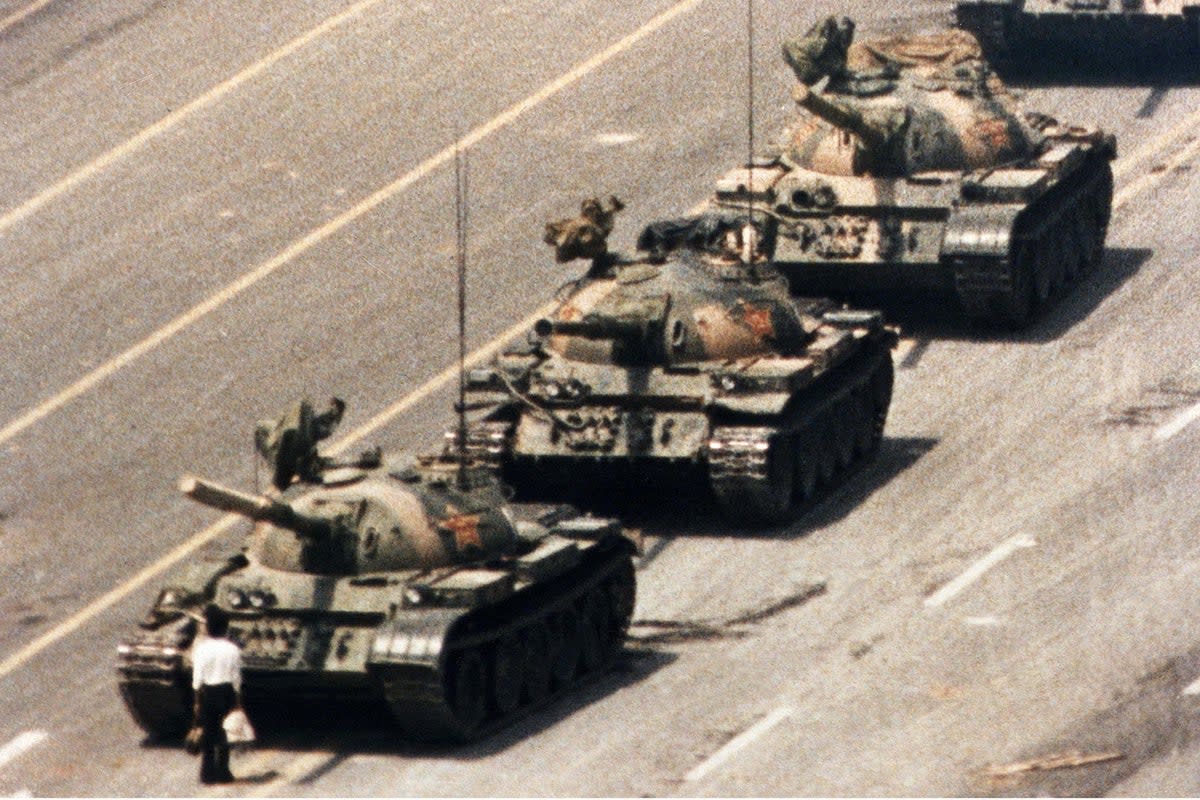Tiananmen Square massacre: Who was the Tank Man and how is he being remembered today?

Today marks the 31st anniversary of the Tiananmen Square Massacre in Beijing.
Remembered in China more euphemistically as the 4 June incident, the events of that day in early summer 1989 are among the bloodiest in modern political history.
Hundreds of civilians were killed by the 200,000-strong People’s Liberation Army in a brutal crackdown on student pro-democracy protesters that sent shockwaves around the world.
The military had been called in after Deng Xiaoping’s governing Communist Party of China (CPC) declared martial law in the capital, seeking to end six weeks of nationwide demonstrations.
One million Chinese youth had occupied the famous landmark to stage hunger strikes and call for an end to state corruption, greater transparency and increased civil liberties following the death of reform-minded party leader Hu Yaobang on 15 April.
The demonstrations in Tiananmen Square were proving an embarrassment to the Chinese government ahead of the visit of Soviet premier Mikhail Gorbachev, whose arrival would pull China into the global media spotlight, hence the sudden urgency to clear the streets.
After initially trying to use non-violent methods to disperse the demonstrators and then telling them they had one hour in which to leave, members of the 27th Group Army opened fire on the crowd with automatic rifles just five minutes later. Snipers rained down bullets from rooftops, troops bayoneted the injured and armoured personnel carriers rolled in, many of which ran over students who had linked arms to form human chains.
The bodies were cleared away by bulldozers for incineration and blood was hosed into the gutters. The wounded were raced to hospital in bicycle rickshaws.
While the CPC insisted the massacre was necessary to avoid a “counter-revolutionary riot”, then US president George HW Bush denounced the violence and prime minister Margaret Thatcher said she was “shocked and appalled”.
China officially recorded the number of dead as no more than 300 while the Chinese Red Cross on the ground said it was more like 2,700. But Sir Alan Donald, Britain’s ambassador to China at the time, said the death toll was much higher.
Writing in a contemporary memo that was only declassified in 2017, Sir Alan expressed his belief that the number of dead was really 10,454 and suggested that the 27th Group Army, “60 per cent illiterate and called primitives”, had been especially chosen for the task because of its reputation for unquestioning obedience.
In another piece of recently declassified correspondence, the same diplomat had warned Downing Street that the massacre was inevitable. “The Chinese government has decided that there is no way to avoid bloodshed,” he wrote 20 May 1989.
Tiananmen Square is most commonly remembered for the Tank Man, one of the most iconic protest images ever recorded: a lone man holding two shopping bags standing immovable in the path of four tanks.
This extraordinary moment was captured by five foreign press photographers from a hotel balconies looking down on the horrors below. Stuart Franklin’s version appeared in Time and Life magazines after the roll of film was smuggled out of China inside a box of tea. Charlie Cole, whose picture won the 1990 World Press Photo of the year, only managed to get his film out after concealing it inside a toilet when the authorities raided his room, forcing him to surrender a dummy roll and sign a confession that he had taken photographs in contravention of martial law. Stuart Widener’s picture for AP was the most widely distributed.
The Tank Man has been identified as 19-year-old archaeology student Wang Weilin, but his fate remains unknown. General secretary Jiang Zemin denied any knowledge of his arrest but insisted he would not have been run over or subsequently executed. Some believe he escaped to Taiwan.
His story was made the subject of Lucy Kirkwood’s play Chimerica in 2013.
Today, Tiananmen Square is never mentioned in Chinese media and is not taught in schools. A heightened police presence at the site is the only tacit nod to what occurred there 29 years previously.
The current US secretary of state, Mike Pompeo, has however called on China to “make a full public accounting of those killed, detained or missing”.
Chinese artist Badiucao has also inspired a social media campaign to mark the anniversary, encouraging young people around the world to dress as the Tank Man and pose in front of significant landmarks to express their opposition to China’s still authoritarian government. The bags they brandish commonly feature images of the children’s cartoon characters Winnie the Pooh and Peppa Pig, both outlawed by Beijing.
Read more
China’s defence minister says Tiananmen Square massacre was justified
Inflatable tank appears in Taiwan to mark Tiananmen Square anniversary
Repression in China at worst level since Tiananmen Square, HRW says

 Yahoo News
Yahoo News 
